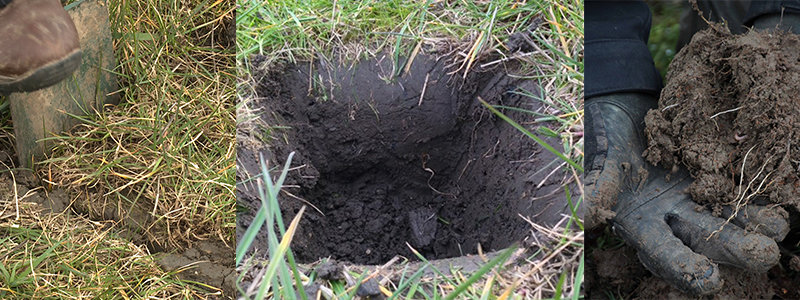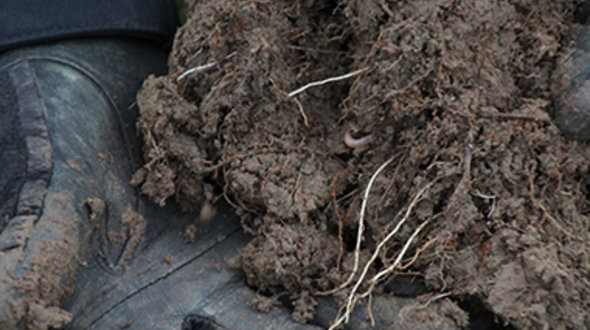Step 2 - Think Soils
Step 2, of our 4-step guide, covers soil management, essential to achieving productive grassland.
Missed Step 1? Revisit these essentials grassland management stages.

Missed Step 1? Revisit these essentials grassland management stages.
NUTRIENTS AND STRUCTURE
There is a saying: It isn’t the animal or the bag that feeds the crop, it’s the soil. Looking after soil fertility and structure are the two key fundamentals of any good grassland management scheme. Soil structure affects root penetration, water availability and soil aeration - so it’s important to take time to look at your soil structure and make sure it is healthy and capable of giving your grass exactly what it needs.
Good soil structure has many benefits. It allows the roots of crops to go much deeper into the earth, providing a better supply of water and allowing crops to access the full range of benefits from the soil. Land with a good soil structure will drain more quickly in the spring and take longer to wet up in the autumn, giving you a longer, safe working period on the land.
Poor soil structure can lead to increased surface water runoff, poor yields and excessive use of nutrients and pesticides. There are many ways to tackle poor soil structure. These need to be tailored to the unique needs of each field.
Ideally soil sampling should be conducted every 3 – 5 years to help maintain healthy soil conditions and correct any issues that arise. Soil sampling can take place at any time of year but is best done when the soil is moist. If the soil is too dry or too wet it is difficult to obtain a representative sample. Roots are best seen in an established crop or for some months after harvest. Ideally, you should soil sample six months before reseeding to allow time for any deficiencies to be rectified before sowing valuable seed.
SOIL SAMPLING
When soil sampling, pay particular attention to areas prone to compaction. Possible areas of runoff should be examined, for example, headlands and wet spots. Areas where crop growth is poor should also be looked at.
Normally you’ll need to dig at least three holes need to be dug in a field to get an accurate reflection of the field’s condition. More holes may be needed in large fields and where there are a range of soil types. Mark out a square area of about 50cm then dig down to a depth of at least 30 – 40cms. Take a close look at the soil structure you’ve dug out. If the grass roots aren’t penetrating below 10cm then you are dealing with a clear case of compaction. Another sign is the water content of the soil. If the soil is bone dry from 7 - 15cms down then that’s another sign of compaction.
Soil pH is more important than NPK. To enable nutrients to be optimally available to the plant’s roots, aim for a pH of at least 6, especially where clover is sown and P & K indices of 2/moderate. Just a small decline in target pH to 5.5 can reduce grass yields by 35-40%. The more acidic the soil, the greater the chance of lock up – which makes vital nutrients unavailable to plants.
Remember to consider trace elements. Some bedrocks are deficient in particular elements, which are important to cattle. If the elements are not present in the soil, they cannot be taken up by grass and so need to be supplied by other methods e.g. supplementation, fertilisers or boluses.
Farm Yard Manures (FYM) are another important source of nutrients. The table below shows typical values, however these can vary by enterprise, application timing and ground conditions. It is therefore essential to analyse batches of FYM to make best allocation of nutrients within a farm nutrient management plan.
| Manure | Available N (kg/t) | Available P (kg/t) | Available K (kg/t) |
| Cattle Slurry | 1.2 | 0.6 | 2.9 |
| Cattle Manure (old) | 0.6 | 1.9 | 7.2 |
| Pig Slurry | 2.5 | 0.9 | 2.2 |
| Broiler Litter | 10.5 | 15 | 16.2 |
Farmers looking for advice on soil management best practice can contact the Barenbrug team for more information or can consult Refer to Nutrient Management Guide (RB209) produced by the Agriculture & Horticulture Development Board.


Read our soil and grassland forage sampling guide here

Once step 2 is complete move on to Step 3, planning.